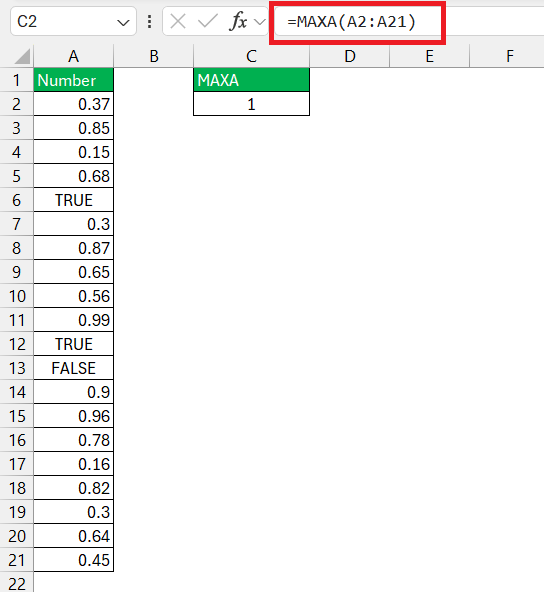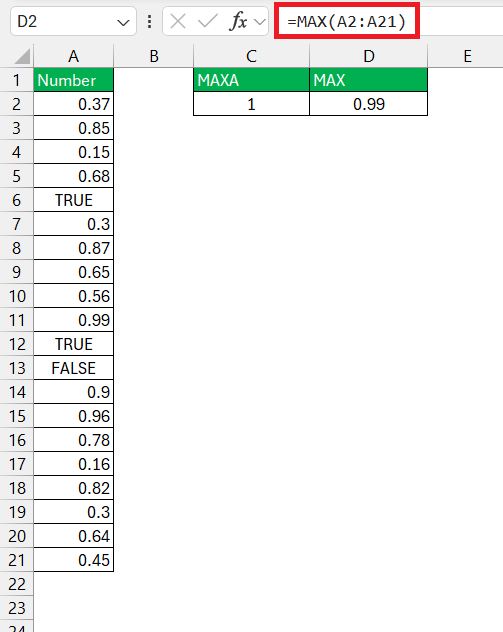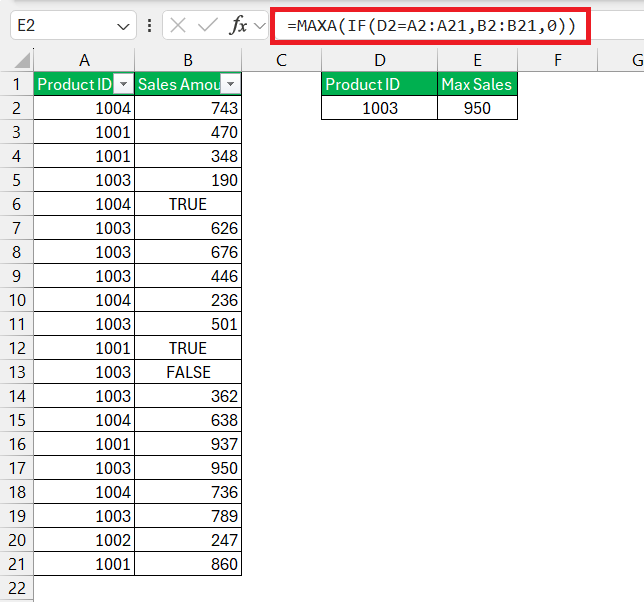MAXA stands as a versatile tool within Microsoft Excel, adept at delving into datasets that contain a mix of numbers and text. Acting like a sieve, it filters through the minutiae to extract the peak value, ensuring no figure goes unnoticed. MAXA function is particularly handy when working with complex datasets where traditional numerical-only functions fall short.
Key Takeaways:
- MAXA is designed to handle datasets containing a mix of numbers, text, and logical values, making it more versatile than the traditional MAX function, which only considers numerical values.
- Unlike MAX, which ignores text and logical values, MAXA includes TRUE as 1, FALSE as 0, and text as 0 in its calculations. This inclusivity ensures comprehensive data analysis without overlooking any data type.
- By combining MAXA with IF statements, you can conditionally find the maximum value in a range based on specific criteria. This makes it an excellent tool for targeted data analysis within larger datasets.
- MAXA can be used within array formulas to evaluate complex conditions and datasets. This feature is particularly useful for users who need to perform advanced data manipulations and calculations.
Table of Contents
Introduction to MAXA in Excel
Unveiling the Power of MAXA
MAXA stands as a versatile tool within your Excel arsenal, adept at delving into datasets that contain a mix of numbers and text. Acting like a sieve, it filters through the minutiae to extract the peak value, ensuring no figure goes unnoticed. To fully grasp its utility, imagine a dataset that’s a kaleidoscope of various data types; MAXA embraces this diversity, treating both numbers and text as contenders in the race to the top.
When and Why to Use the MAXA Function
You’d find the MAXA function incredibly handy when facing datasets that are not purely numerical. Say you’re evaluating survey data, where respondents marked their satisfaction levels with numerical scores, but some opted for qualitative responses like ‘good’ or ‘excellent.’
Or perhaps, you are crunching sales data with some cells holding ‘N/A’ for products not offered in certain regions. In these scenarios, the MAXA function comes to the rescue by not neglecting text and logical values—TRUE or FALSE—treating them as 1 and 0 respectively, thereby providing a result that encompasses all data types.
The Anatomy of MAXA
Breaking Down the Function Syntax
Diving into the MAXA function, you’ll find it quite straightforward. Its basic structure goes like this: =MAXA(value1, [value2], ...). The function demands at least one argument, but up to 255 can be tagged along. It’s crucial to note that these values can be a mix of numbers, cell references, arrays, or even other formulas.
This eclectic acceptance makes MAXA a potent function for evaluating a broad spectrum of data elements, from the blatantly obvious to the often overlooked logical and text entries in your spreadsheets.
Basic MAXA Formula Construction
To construct a basic MAXA formula, you start off by typing =MAXA( into a cell followed by the numbers or cell references you wish to compare. You could input individual numbers or ranges. For instance, =MAXA(A1, B1, C1) will compare the values in cells A1, B1, and C1, while =MAXA(A2:A21) will assess the range from A2 to A21. After entering your desired arguments, close the formula with a parenthesis and press Enter.
Voila! Excel then evaluates and displays the maximum value taking into account numbers, text, and logical values.
Understanding MAXA vs. Traditional MAX
When you compare MAXA to its elder sibling, the traditional MAX function, the key distinction lies in their treatment of data varieties. MAX is the purist, turning a blind eye to anything that’s not a number. Text and logical values?
It passes them by without a second glance. MAXA, on the other hand, is the all-embracing counterpart, considering TRUE and FALSE as 1 and 0, and text as zero, integrating them into its quest for the maximum value. Both functions will appraise numbers disguised as text the same way if you feed them directly into the formula.
Tips and Tricks for Excel Pros
MAXA with IF Function
In Excel, you can combine the MAXA function with an IF statement to find the maximum value in a range that meets certain criteria. Here’s how you can do it using an array formula:
Suppose you have a dataset with sales amounts and product IDs. You want to find the maximum sales amount for a specific product ID. You can use this formula to get the result –
=MAXA(IF(D2=A2:A21,B2:B21,0))
- IF(D2=A2:A21,B2:B21,0): This part creates an array where each element is the sales amount from column B if the corresponding product ID in column A is “1003”. Otherwise, it returns FALSE.
- MAXA: This function then calculates the maximum value in this array, ignoring the FALSE values.
If you are using Excel 2019 or earlier, after typing the formula, press Ctrl+Shift+Enter to enter it as an array formula. In Excel 365, you can simply press Enter.
Overcoming Common MAXA Challenges
Dealing with Non-Numeric Values
Encountering non-numeric values doesn’t have to be a roadblock when using MAXA. For instance, when MAXA faces text entries amidst numbers, it treats them as zeros instead of causing a #VALUE! error. This means you can carry on finding the maximum value even when your dataset comprises various customer feedback forms with both ratings and comments. However, remember that when dealing with these non-numeric values, MAXA might return zero as the maximum value if no numeric value outstrips it, which could skew interpretation if overlooked.
Interpreting MAXA Results Accurately
Precision in interpreting MAXA results is key to harnessing its full potential. MAXA will count TRUE as 1 and FALSE as 0, a nuance that can impact your outcome significantly. If you’re looking at survey data where ‘1’ represents ‘Excellent’ and ‘0’ stands for ‘Poor’, MAXA helps by including these logical values in its quest for the highest score. However, be cautious when the dataset has logical values mixed with numbers, as TRUE could be misconstrued as a numeric ‘1’. Careful examination ensures the insights you draw are as accurate as the functions you rely on.
Real-World Applications of MAXA
Finding the Maximum in Varied Datasets
The real value of MAXA shines when it’s applied to eclectic datasets where data anomalies are not just possible but expected. Let’s say you’re a real estate analyst sifting through property listings, some with prices and others labeled ‘TBD’.
A simple use of =MAXA(range) ensures that even non-traditional values are considered in your search for the property with the highest price tag. Or if you’re a teacher, tallying up test scores, including extra credits marked as ‘bonus’, MAXA can seamlessly pick the top scorer out of the bunch, bonuses included.
Enhancing Data Analysis with MAXA Insights
MAXA serves as your analytical magnifying glass for inspecting the expanse of complex data. Beyond just fetching the highest value, it empowers you to peer into practices and patterns. Imagine analyzing customer service ratings where scores intermingle with textual feedback, or tying in sales figures with sporadic out-of-stock notifications. MAXA doesn’t just identify peaks; it helps you pinpoint outliers and exceptional instances, offering insights into both quantitative and qualitative aspects of your data terrain.
FAQs About Using MAXA in Excel
How to use the maxa function in Excel?
To use MAXA in Excel, simply select the cell where you want the result, type =MAXA(, add your desired arguments—like numbers, cell references, or ranges—separated by commas, then close with a parenthesis and press Enter. The function will then compute and display the largest value, considering both numbers and logical values.
What is the difference between Max and Maxa function?
The key difference between MAX and MAXA is their treatment of non-numeric data. MAX ignores text and logical values completely while MAXA counts TRUE as 1, FALSE as 0, and text as 0 within its calculation. Both evaluate numbers represented as text when they are directly supplied as arguments.
What Differentiates MAXA from Other Statistical Functions?
MAXA is distinctive among statistical functions due to its inclusion of logical and text values in calculations, which other statistical functions generally ignore. Unlike functions that focus solely on numeric data, MAXA considers the entire range of data, which means it can operate on a more varied set of information within Excel datasets.
Can MAXA Be Used with Conditional Formatting?
Absolutely, MAXA can be teamed with conditional formatting to visually emphasize the highest value in a dataset. By setting up rules that spotlight the cell with the MAXA result, you can instantly draw attention to standout figures, valuable when you’re looking to quickly identify peaks amidst a sea of data.
How Does MAXA Handle Logical Values and Text?
MAXA takes logical values and text into account by assigning them numeric values where TRUE is treated as 1, FALSE as 0, and text—excluding numbers stored as text—as 0. This enables MAXA to encompass a wider range of data types when calculating the maximum value in a given dataset.
John Michaloudis is a former accountant and finance analyst at General Electric, a Microsoft MVP since 2020, an Amazon #1 bestselling author of 4 Microsoft Excel books and teacher of Microsoft Excel & Office over at his flagship MyExcelOnline Academy Online Course.










